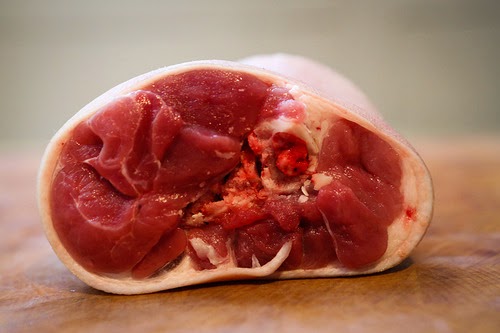Autumn caviar and confit de canard
This early autumn, I attended Nel Schellekens’ open day at the Keunenhuis once again. I tasted Papeda made by two ladies from Indonesia. Papeda is essentially a starchy congee made from sago starch; however, they claimed they couldn't find sago starch, so they used potato starch instead. It is typically eaten with a turmeric fish broth, and the ladies offered a choice between a mackerel and cuttlefish broth. I asked if they used any rawit chili at all, but they said no, explaining, “It’s too spicy for Dutch people.” I was disappointed, as I didn’t taste any complex flavors. However, from what I could see, all the ingredients for Ikan Kuah Kuning can be purchased in the Netherlands. They also gave me a half raw lombok chili to nibble on, but soon my attention turned to the Achterhoekse caviar.
Small agricultural farms are increasingly difficult to sustain in the Netherlands In 1999, a farmer in Laren began farming eels, but due to high investment costs, they switched to farming Russian sturgeon and Siberian sturgeon. They sell both the fish meat and caviar. For €9.00, I bought a small plate that included potato salad, sturgeon fillet, and a spoonful of caviar—quite nice! Now, when I want to treat myself, I know I can buy locally made caviar. They even offer ossetra for less than € 30 for a 20-gram can.
Siberian sturgeon
Orléans
A few days later, my work took me to Orléans in France, a city I had never visited before. In medieval France, many cities owed their existence to bridges over dangerous rivers, and Orléans is no exception. Jeanne d'Arc helped lift a siege during the Hundred Years' War, after which the city prospered, partly due to its proximity to Paris.
The Basilique Cathédrale Sainte-Croix d'Orléans is relatively modern; although a medieval cathedral once stood on this site, construction of the current building began in 1601 and was completed in 1829.
On our first night, we arrived too late for dinner in the city center, but on the second night, we visited Le Brin de Zinc at 62-64 Rue Sainte-Catherine. It’s a small bistro-style restaurant where I ordered confit de canard along with a glass of red wine. I must say, it was simple but very, very tasty. We forgot to order crudités, but we had enjoyed a half-liter glass of ice-cold beer earlier; beer as an entrée—who cares?
I once made confit de canard at home, and it was quite expensive because I had to buy a lot of duck fat.
















